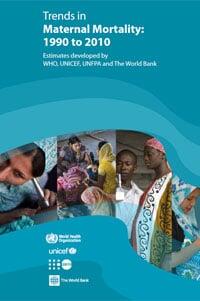UNITED NATIONS, New York – The number of women dying of pregnancy and childbirth related complications has almost halved in 20 years, according to new estimates released today by the World Health Organization (WHO), United Nations Children's Fund (UNICEF), United Nations Population Fund (UNFPA) and the World Bank.
"I am very pleased to see that the number of women dying in pregnancy and childbirth continues to decline. This shows that the enhanced effort of countries, supported by UNFPA and other development partners, is paying off. But we can’t stop here. Our work must continue to make every pregnancy wanted and every childbirth safe," said Dr. Babatunde Osotimehin, Executive Director of UNFPA, the United Nations Population Fund.
The report “Trends in maternal mortality: 1990 to 2010”, shows that from 1990 to 2010, the annual number of maternal deaths dropped from more than 543,000 to 287,000 – a decline of 47 per cent. While substantial progress has been achieved in almost all regions, many countries particularly in sub-Saharan Africa will fail to reach the Millennium Development Goal (MDG) target of reducing maternal death by 75 per cent from 1990 to 2015.
Every two minutes, a woman dies of pregnancy-related complications, the four most common causes being: severe bleeding after childbirth, infections, high blood pressure during pregnancy, and unsafe abortion. Ninety-nine per cent of maternal deaths occur in developing countries; most could have been prevented with proven interventions.
“We know exactly what to do to prevent maternal deaths: improve access to voluntary family planning, invest in health workers with midwifery skills, and ensure access to emergency obstetric care when complications arise. These interventions have proven to save lives and accelerate progress towards meeting the Millennium Development Goal 5," said Dr. Osotimehin.
Disparity exists within and across countries and regions. One third of all maternal deaths occur in just two countries – in 2010, almost 20 per cent of deaths (56,000) were in India and 14 per cent (40,000) were in Nigeria. Of the 40 countries with the world’s highest rates of maternal death, 36 are in sub-Saharan Africa.
Similarly, Eastern Asia, which made the greatest progress in preventing maternal deaths, has a contraceptive prevalence rate of 84 per cent as opposed to only 22 per cent in sub-Saharan Africa, a region that has the highest rates of maternal death.
"Over a quarter of a million women still die in pregnancy and childbirth each year, and more than 215 million women lack access to modern contraceptives. Meeting the need for voluntary family planning for these women would not only fulfill a human right, it would also reduce the number of maternal deaths by a third. This is a highly cost-effective public health strategy,” said Dr. Osotimehin.
The report also highlights:
- In 2010, the global maternal mortality ratio was 210 maternal deaths per 100,000 live births. Sub-Saharan Africa had the highest maternal mortality ratio at 500 maternal deaths per 100,000 live births.
- In sub-Saharan Africa, a woman faces a 1 in 39 lifetime risk of dying due to pregnancy or childbirth-related complications. In South-eastern Asia the risk is 1 in 290 and in developed countries, it is 1 in 3,800.
- Ten countries have 60 per cent of the global maternal deaths: India (56,000), Nigeria (40,000), Democratic Republic of the Congo (15,000), Pakistan (12,000), Sudan (10,000), Indonesia (9,600), Ethiopia (9,000), United Republic of Tanzania (8,500), Bangladesh (7,200) and Afghanistan (6,400).
- Ten countries have already reached the MDG target of a 75 per cent reduction in maternal death: Belarus, Bhutan, Equatorial Guinea, Estonia, Iran, Lithuania, Maldives, Nepal, Romania and Viet Nam.
An important challenge that makes it difficult to assess progress accurately is the lack of reliable information about maternal deaths. In many developing countries, deaths may go uncounted and frequently the cause is not recorded correctly, particularly when women die at home. This has been accounted for in the current analyses of estimates.
"These new estimates demonstrate how maternal health is progressing globally and how the quality of data is improving. This also shows how the UN works together to improve the situation for women and girls around the world," said Dr. Osotimehin.
“Trends in maternal mortality: 1990 to 2010” includes a detailed description of the methodology and the underlying data used to develop the estimates.
For more information, please contact:
In Bangkok: William A. Ryan, mobile +66 89 897 6984, ryanw@unfpa.org
In New York: Katja Iversen, tel. +1 212 297 5016, iversen@unfpa.org, or
Omar Gharzeddine, tel. +1 212 297 5028, gharzeddine@unfpa.org


